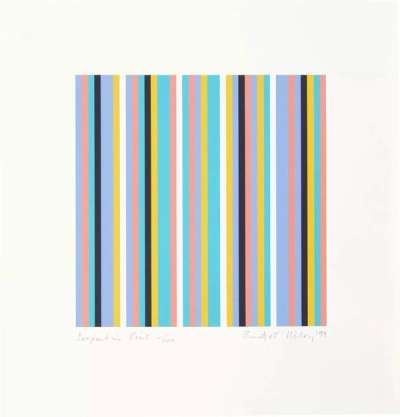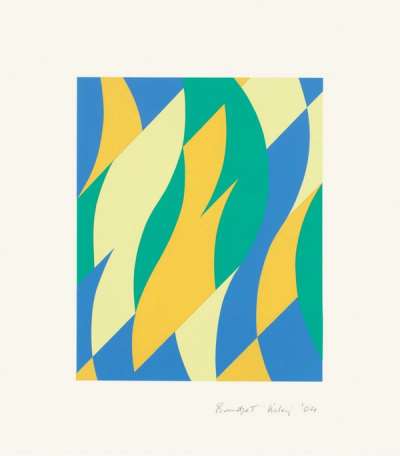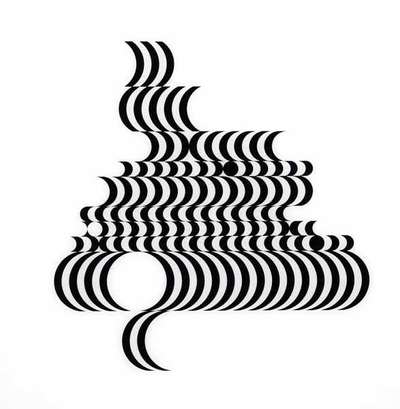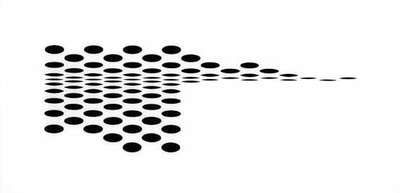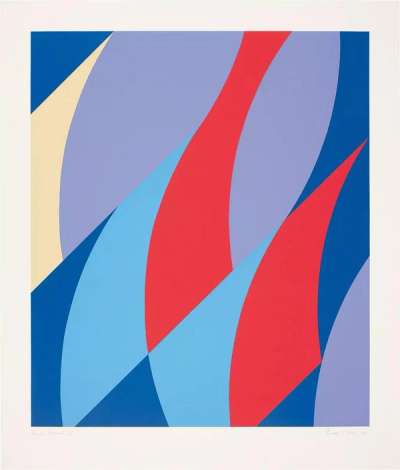 Image © Christie's / Soeglet © Victor Vasarely 1983
Image © Christie's / Soeglet © Victor Vasarely 1983 
Victor Vasarely
31 works
Victor Vasarely (1906-1997) was a Hungarian-French artist widely regarded as the father of Optical Art, commonly known as Op Art. Born in Pécs, Hungary, Vasarely studied at the Podolini-Volkmann Academy of Art and Design in Budapest before moving to Paris in 1930. He worked as a graphic designer there and created innovative abstract works featuring geometric shapes, lines, and patterns.
Victor Vasarely: Pioneering the Realm of Optical Abstraction
Optical illusions and scientific principles inspired Vasarely's art, and he sought to create works that would engage and challenge the viewer's perception. He experimented with different materials and techniques, including painting, printmaking, and sculpture, and developed a signature style that featured bold, contrasting colours and precise geometric shapes.
Vasarely's breakthrough culminated during the mid-1950s, when he created works that skillfully employed the illusion of movement and depth through optical effects. These works, known as Op Art, were an innovative sensation and helped establish Vasarely as a leading figure in the international art world. His art has been exhibited in major museums and galleries worldwide, and his influence is evident in the work of many contemporary artists. In 1976, Vasarely founded the Vasarely Foundation in Aix-en-Provence, France, to promote and preserve his artistic legacy.
 Image © Op Art Gallery/ Tekers-MC © Victor de Vasarely 1981
Image © Op Art Gallery/ Tekers-MC © Victor de Vasarely 1981Vasarely’s Contribution to the Op Art Movement
Considered the father of the Op Art movement, Vasarely’s artistic oeuvre explored the realm of optical illusions, geometric configurations, and vibrant hues, strategically employed to create visual phenomena that disrupt the viewer's perception of spatial awareness. In his early artistic endeavours spanning the 1930s and 1940s, Vasarely explored organic shapes and subdued colour palettes. His later trajectory evolved towards more abstract and geometric forms, characterised by vivid hues and monochromatic juxtapositions. A significant body of Vasarely’s work comprises black-and-white studies featuring diverse figures, representing his initial exploration of movement-based and illusionary abstraction. His various depictions of zebras and other animals are highly acclaimed among these notable works. Vasarely meticulously utilised the inherent geometric patterns in the genetic makeup of wild animals, employing them to create a dynamic illusion movement.
Vasarely's work was highly influential in forming Op Art as a movement and aesthetic. Other notable artists associated with the movement include Bridget Riley, Richard Anuszkiewicz, and Josef Albers.
Vasarely's legacy resonates in the realm of contemporary art today, as many artists continue to explore the use of optical illusions and geometric forms in their practice. His profound influence on the Op Art movement is significant, and his contributions have indelibly shaped our understanding of art and perception.
Why Invest in Victor Vasarely?
Investing in Victor Vasarely can be lucrative for those interested in modern contemporary art. Vasarely's work is sought after by collectors for its hypnotising visual appeal, historical significance, and rarity. As the progenitor of Op Art, his influence on the movement is immeasurable, and his work continues to inspire artists today. Vasarely’s practice spans various decades, each demonstrating the ambitious shifts and adaptations to his creative process. His works were admired by celebrities, and they continue to make appearances in secondary and primary markets. Christie's will offer a Vasarely painting in the upcoming New York Post-War and Contemporary Art Day Sale in May 2023 and is estimated to achieve $150,000.
Furthermore, Vasarely's work has been featured in major worldwide museums and exhibitions, including the Museum of Modern Art in New York, the Centre Pompidou in Paris, and the Stedelijk Museum in Amsterdam. As such, his work is considered an integral contribution to modern contemporary art and art history and is sought after by private and institutional collectors.
 Image © Guggenheim / Vega III © Vasarely 1997
Image © Guggenheim / Vega III © Vasarely 1997Tips for Building a Vasarely Print Collection
If you're interested in building a collection of Victor Vasarely prints, several tips can help you get started:
- Do your research: Before making any purchases, educate yourself on Vasarely's work and the market for his prints. This will help you make informed decisions and avoid overpaying. To learn more, refer to our guide on navigating the blue-chip art market.
- Work with a reputable dealer: When purchasing Vasarely prints, it's important to work with a dealer who has experience with his work and a good reputation. MyArtBroker has a team of specialists that can help you navigate the ambiguities of an artist's market. Our newly launched MyPortfolio can help you track the value of your artwork and provides an overview of an artist's market performance.
- Consider the condition: The condition of a print can greatly impact its value. Invest in prints that are in good condition and have been well-maintained over the years.
- Invest in rare or limited edition prints: Limited edition prints or rare prints that are hard to come by may hold greater value over time. Look for prints signed and numbered by the artist, as these are often more valuable than open-edition prints. To learn more about art investment, read our 2023 Market Guide.
- Diversify your collection: Rather than focusing on one specific print or series, consider building a diverse collection that showcases the range of Vasarely's work. This can include prints from different series, sizes, and colour schemes. By following these tips and utilising MyArtBroker's MyPortfolio management tool, you can build a collection of Vasarely prints that brings you joy and holds its value as an investment over time. Our Buyer's Guide to prints and editions can help you get started.
How to Determine the Value of Victor Vasarely Prints & Editions
Determining the value of Victor Vasarely prints and editions can be a complex process that involves various factors, including the rarity and condition of the artwork, the artist's reputation and market demand, and the specific edition or series the artwork belongs to. Here are some tips to help you determine the value of Vasarely prints and editions:
- Research the market: Look at recent auction results and sales data from reputable art dealers and galleries to understand current market values for Vasarely prints and editions.
- Consider the edition size: Vasarely created many prints in limited editions, so the smaller the edition size, the higher the value of the print is likely to be.
- Condition is key: The condition of the print can have a significant impact on its value. Prints in excellent condition, with no fading, staining, or damage, are typically more valuable.
- Consider the artwork's significance: Vasarely is a highly regarded artist and a pioneer of the Op Art movement. The importance of the artwork within Vasarely's oeuvre can influence its value.
- Work with an art advisor or appraiser: Consulting with an art advisor or appraiser can help you navigate the complexities of the art market and provide you with a more accurate assessment of the value of your Vasarely prints and editions.
Regarding managing your art portfolio, MyArtBroker's MyPortfolio platform offers a range of services to help you track the value of your Vasarely prints and editions and other artworks in your collection.
 Image © Musuem Of Fine Art Budapest / Ezinor © Victor Vasarely 1949
Image © Musuem Of Fine Art Budapest / Ezinor © Victor Vasarely 1949What are some of Victor Vasarely’s Most Popular Prints?
Some of Vasarely’s most popular prints include his Vega, Alom and Zebra works. Here are three of Victor Vasarely's prints showing his distinctive style:
- Vega Nor (1969) - features tessellating geometric squares that vibrate and pulsate to and from the surface. Vasarely's Vega works feature distinctive chequerboard patterns which convex and concave in various ways from the pictorial surface.
2. Alom (1966) - features a complex interplay of colours and shapes that create a dynamic visual effect. This work, an oil on canvas, measures 66 x 66 cm and exemplify's Vasarely's bold and innovative style.
3. Zebra (1937) - Vasarely's animal works are also popular as they demonstrate the versatility of Op Art by combining optical illusion with figuration and form. The below work features the bold black-and-white stripes of zebras meticulously arranged in a mesmerising pattern. Vasarely also explored the inherent patterned qualities of various other animals, including tigers. These works are popular as they demonstrate Vasarely's formative years and ambitious experimentation.
 Image © Caminao's Ways / Zebra © Victor Vasarely 1937
Image © Caminao's Ways / Zebra © Victor Vasarely 1937How to Authenticate Victor Vasarely Prints & Editions
Authenticating Victor Vasarely's prints and editions can be challenging, especially for those without specialised knowledge of his works. However, there are a few things to remember when determining the authenticity of a Vasarely print or edition.
First, it's important to look for signatures or other identifying marks that indicate Vasarely or his studio produced the work. This can include a signature, edition number, or other markings unique to Vasarely's prints.
Second, it's important to research the print or edition in question. This can involve consulting specialised catalogues or databases of Vasarely's works and consulting with experts in the field.
Third, it's important to consider the condition of the print or edition. Prints in poor condition or restored may not be as valuable as those in excellent condition.
Some additional tips for authenticatingVasarely prints and editions include examining the paper and ink used in the printing process, looking for any signs of wear or ageing, and comparing the work to other known examples of Vasarely's prints.
 Image © Tate / Nives II © Victor Vasarely, 1949-58
Image © Tate / Nives II © Victor Vasarely, 1949-58How Do You Check the Condition of a Victor Vasarely Print?
Checking the condition of a Victor Vasarely print is an essential step before purchasing or selling a piece. Here are some tips on how to assess the condition of a Vasarely print:
- Inspect the paper: Check for any signs of discolouration, yellowing, or fading of the paper. If the paper is stained, creased, or has visible tears or holes, it can significantly affect the value of the print.
- Examine the ink: Look closely at the ink to see any signs of fading or smudging. If the ink has bled through the paper or is not crisp and sharp, it could indicate poor printing quality or that the print has been damaged.
- Check for foxing: Foxing is a type of age-related staining that can occur on paper. It appears as small brown spots or patches and can significantly reduce the value of a print.
- Assess the framing: The framing of a print can also affect its condition. Check for any signs of damage, such as scratches or dents on the frame. The matting and backing should also be inspected for any signs of discolouration or damage.
If you are unsure about the condition of a Vasarely print, it is always recommended to seek the advice of a professional art appraiser or art dealer. MyArtBroker offers art appraisal services and can help you determine the condition and value of your print. To explore this theme further, read our guide to restoring and caring for modern and contemporary prints.
 Image © Tate / Supernovae © Victor Vasarely, 1959-61
Image © Tate / Supernovae © Victor Vasarely, 1959-61Where Can I Buy a Victor Vasarely Print in 2023?
There are various places to acquire a Victor Vasarely print in 2023. One option is to purchase directly from the Vasarely Foundation's website, which features a selection of prints and editions available for sale. When purchasing a Vasarely print, it is recommended to work with a trusted art advisor or broker, such as MyArtBroker, who can provide expert guidance on navigating the art market and purchasing prints confidently.
Another option is visiting reputable art galleries specialising in Vasarely's work. These galleries often have a range of prints available and can provide expert guidance on purchasing and collecting Vasarely's prints. Auction houses are also an option for purchasing works. Major auction houses such as Christie's, Sotheby's, and Phillips regularly feature Vasarely's work in their sales, and they often provide detailed information on the condition and provenance of the prints.
Online marketplaces such as eBay may also have Vasarely prints available for purchase. However, it is important to do proper research and ensure that the seller is reputable and the print is authentic before purchasing to avoid encountering fakes and forgeries.
 Image © WikiArt / Vonal Stri © Victor Vasarely 1975
Image © WikiArt / Vonal Stri © Victor Vasarely 1975Why Use MyArtBroker to Find Your First Victor Vasarely?
At MyArtBroker, we provide a safe and simple solution to buyers by connecting you directly with our expert brokers, who can assist you in your search with our large network of collectors looking to buy and sell daily if you are looking to purchase a specific piece of Victor Vasarely art to either start or grow your collection. Our brokers will also conduct condition checks and authenticate artwork so you can buy with confidence.
 Image © WikiArt / Tigres © Victor Vasarely 1938
Image © WikiArt / Tigres © Victor Vasarely 1938A Dedicated Broker
With MyArtBroker, you will have access to a dedicated broker who will guide you through the entire process of purchasing a Vasarely print. The broker will help you identify the most suitable prints for your collection based on your preferences and budget. They will also provide expert advice on authenticating and valuing Vasarely prints. Get in touch to chat with one of our friendly specialists.
Our Network (reference Trading Floor)
Our global network consists of over 30,000 collectors buying and selling works daily, and dealers, collectors, galleries, and independent experts working with us to ensure we can offer the most covetable and authentic Vasarely works. Our website has 85,000+ visitors every month, and we regularly publish pieces tracking the artist’s market performance on Edition Magazine, keep up to date with new works, auction results and news, as well as updated biographies and informative essays on all Vasarely editions.
MyArtBroker's Trading Floor is a unique feature allowing you to connect with collectors, dealers, and brokers who specialise in Victor Vasarely prints. This network provides you with a wealth of knowledge and expertise to build your collection.
Collecting Victor Vasarely Prints with MyArtBroker
MyPortfolio is MyArtBroker's portfolio management tool that allows you to keep track of your Vasarely print collection in one place. You can use MyPortfolio to monitor the value of your collection, keep track of your purchases, and view your collection's growth over time. This tool provides valuable insights into Vasarely’s print market and can help you make informed decisions about buying and selling Vasarely prints at the right time.






